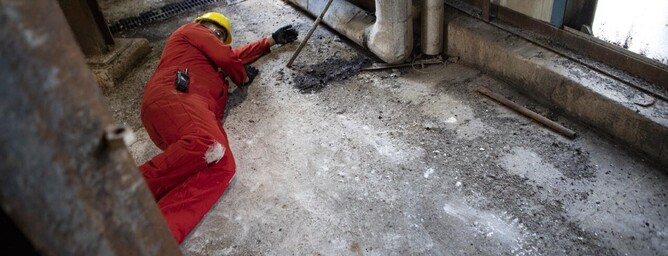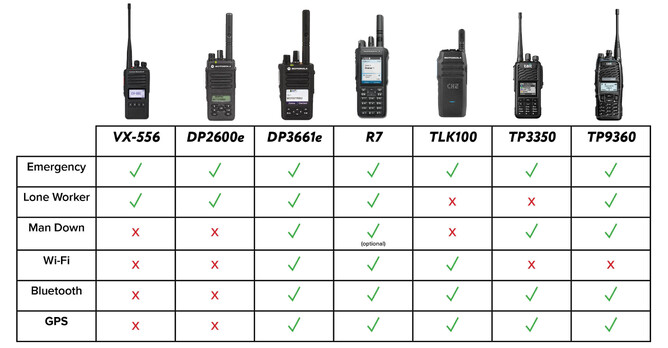In today's fast-paced and dynamic work environments, ensuring the safety of employees is paramount. As technology continues to evolve, so do the tools and devices designed to enhance workplace safety. Two-way radios, once solely communication tools, have evolved into powerful instruments equipped with specialized safety features. In this blog post, we'll delve into the unique safety features of two-way radios, exploring how these functionalities contribute to safeguarding employees in various industries. From GPS tracking to man-down detection capabilities, these features not only facilitate seamless communication but also play a crucial role in emergency response and incident management. Join us as we uncover the innovative safety solutions embedded within modern two-way radios and their significance in promoting workplace safety.
Emergency Button
Having an emergency alert button is essential as it can save crucial time and potentially the life of an operator. In some radios, this feature is identified as the 'Panic button'.
Two-way radios with an emergency alert feature enable operators to seek assistance with a simple button press. This triggers an alarm throughout the network, facilitating immediate mobilization of help to reach the operator swiftly. Ensuring the emergency alert button is easily accessible is paramount.
Here’s an example of how effective the emergency button can be:
During a warehouse operation, John, a warehouse worker, witnesses a hazardous chemical spill. Recognizing the imminent danger, he swiftly presses the emergency button on his radio. Instantly, the distress signal is transmitted to the central control room, alerting the safety team and supervisors. In response, the emergency procedures are immediately enacted, ensuring the rapid evacuation of personnel and the containment of the spill. John's quick action, facilitated by the emergency button on his radio, helps prevent a potential disaster and ensures the safety of everyone in the facility.
Lone Worker
For an individual working alone, having a two-way radio equipped with a built-in 'alive check' function is indispensable. This functionality, often referred to as a lone worker feature, initiates a "check-in alert" if the lone worker fails to engage with the radio within a designated timeframe. If there's no response from the worker, an emergency notification is promptly dispatched across the network, facilitating immediate assistance.
Here’s an example of how effective the Lone Worker feature can be:
Sarah, a technician, is tasked with inspecting utility equipment in remote areas. She ventures into a secluded section of the site, where she's out of sight and earshot from her colleagues. Suddenly, she encounters an unexpected issue with the equipment, and her safety becomes compromised. Fortunately, Sarah's radio has a lone worker feature activated. After a predefined period of inactivity, her radio sends an alert to the team, signalling her potential distress. Promptly receiving the alert, her colleagues rush to her location, ensuring her safety and resolving the issue.
Man Down
The 'man down' feature operates similarly to the lone worker function but differs in that it doesn't require the operator to actively "check in". Instead, it relies on detecting prolonged lack of movement as a signal that help may be needed, indicating potential scenarios like the user falling or losing consciousness, making them unable to physically request assistance. Additionally, some two-way radios with this feature will trigger an alert if they detect a sudden tilt towards the ground, indicating that the user has fallen.
In situations where rapid response is critical, such as severe injury or medical emergencies like heart attacks or strokes, the 'man down' functionality in a two-way radio is essential for ensuring prompt assistance.
Here’s an example of how effective the Man Down feature can be:
Imagine a construction worker, Jack, working alone at a height installing electrical fixtures. Suddenly, he loses his balance and falls. Jack's radio, equipped with a man-down feature, detects the sudden movement and lack of response from Jack. It automatically sends an alert to the team, indicating his precise location (when paired with the GPS function). Thanks to this timely notification, Jack receives immediate assistance, potentially preventing serious injury or worse.
Bluetooth
Bluetooth radios offer more than just convenience—they contribute to your team's safety by removing wires, cords, and cumbersome accessories that could hinder productivity on the job. Radios can connect via Bluetooth to wireless earpieces or headsets, and even wireless RSMs, allowing seamless communication without pesky wires getting in the way.
Here’s an example of how effective Bluetooth can be:
Maria, a logistics manager, is overseeing the loading of trucks in a busy shipping yard. With multiple tasks to coordinate, she needs to communicate with her team while maintaining mobility. Using the Bluetooth feature on her radio, Maria connects wirelessly to her hands-free headset. This allows her to communicate with her team members while remaining hands-free to supervise operations.
GPS Tracking
Two-way radios equipped with built-in GPS facilitate the tracking of worker locations through dispatching software applications, offering numerous advantages to organizations employing remote workers. These radios feature an integrated GPS module, akin to that found in cell phones, enabling precise user location tracking.
The ability to monitor workforce locations and check worker statuses via GPS sends a clear message to employees that their safety is of paramount importance to the organization. Prioritizing the health and safety of employees not only saves money but also enhances productivity.
In the event of an incident, such as a potential man-down situation, GPS technology swiftly provides the distressed user's location, ensuring rapid response from emergency teams. Furthermore, the capability for time and location data stamping streamlines compliance reporting and furnishes accurate records for incident reviews and investigations.
Whilst being a key tool in an emergency, GPS tracking can also assist with other needs of the job, for example:
Tom, a field technician, is dispatched to repair a critical piece of equipment in a remote location. As he navigates unfamiliar terrain, he encounters unexpected road closures and detours. Thankfully, Tom's radio is equipped with GPS functionality, allowing his dispatch team to track his exact location in real-time. When Tom encounters the roadblock, he quickly alerts his team using the radio. With knowledge of his precise location, the dispatch team reroutes him to an alternate path, ensuring he reaches the site promptly.
Wi-Fi
While not a safety feature as such, built in Wi-Fi is an excellent tool for conducting software updates, saving both time and money by the ability to conduct Over the Air Programming (OTAP).
Wi-Fi OTAP provides support to radio managers in the back office as well. It allows them to effectively update the radio fleet, ensuring that updates—some of which may affect worker safety—are carried out promptly.
The safety features of two-way radios represent a crucial advancement in workplace safety technology. By prioritising employee well-being and facilitating swift responses to emergencies, these features play a vital role in creating safer work environments. The table below highlights the safety features available on Mobicomm’s core range of portable radios:


